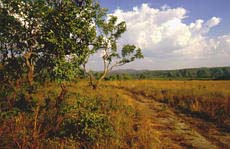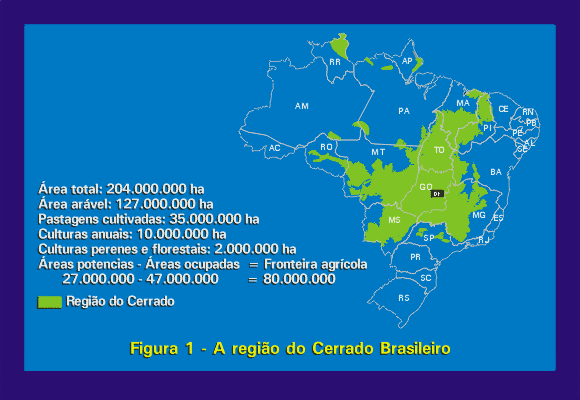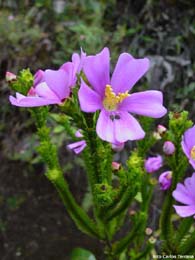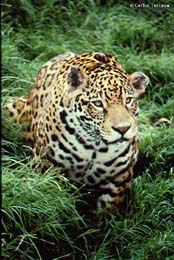|
|
Ads by Google Cerrado - the Brazilian savannas
Cerrado is the regional name given to the Brazilian ecosystem which is similar to savannas.
 The "cerrado" trees are very peculiar, with twisted trunks, covered by a thick bark, and leaves which are usually broad and rigid.
The "cerrado" trees are very peculiar, with twisted trunks, covered by a thick bark, and leaves which are usually broad and rigid. Many herbaceous plants have subterranean organs to store water and nutrients. Thick barks and subterranean structures can be interpreted as some of the many adaptations of this vegetation to the periodic burnings to which it is submitted, in order protect the plants from destruction and making them capable of sprouting again after the fire. It is believed that, as in many savannas in the world, the "cerrado" ecosystems have been coexisting with fire since remote times; initially as natural fires caused by lightening (elsewhere, volcanos may have had influence, too), and later caused by man. Taking advantage of the sprouting of the herbaceous stratum that follows a burning in the "cerrado", the primitive inhabitants of these regions have learned to use the fire as a tool, to increase the fodder offer to their domesticated animals (herbivorous), a fact that happens until today. During the dry season, the trees of cerrado loose their leaves. However, differently from the neighbour ecosystem caatinga, the trees of cerrado do not loose leaves all at once; when some species have already lost all leaves, some still have them yellowish, and others still have green leaves and blossom. Even if each specie is caducipholy (loose leaves for some season), the system as a whole is not; even at the peak of dry season, there are trees with leaves; the cerrado is called semi-caducipholy. Cerrado : Fauna and FloraThe great habitat variability in the different types of "cerrado" supports an enormous diversity of plant and animals species. Recent studies, such as the one presented by J. A. Ratter and other authors in "Avanços no Estudo da Biodiversidade da Flora Lenhosa do Bioma Cerrado" (Advances in the Study of the Biodiversity of the Ligneous Flora of the "Cerrado" Bioma) in 1995,
estimate the number of vascular plants at around 5 thousand; more than 1600 species of mammals, birds and reptiles have already been identified in the "cerrado's" ecosystems ("Cerrado's Fauna", Costa et al., 1981).Among the diversity of invertebrates, the most notable are the termites and the leaf-cutter ants ("saúvas"). They are the main herbivores of the "cerrado", having a great importance in the consuming and decomposition of organic matter, as well as constituting an important food source to many other animal species. Cerrado : business
The urban pressure and the rapid establishment of agricultural activities in the region have been rapidly reducing the bio-diversity of the ecosystems. Until the mid 60's, agricultural activities in the "cerrados" were very limited, directed mainly at the extensive production of beef cattle for subsistence or the local market, since "cerrado" soils are naturally infertile for agricultural production. After this period, however, the urban and industrial development of the Southeast Region has forced agriculture to the Central-West Region. The transfer of the country's capital to Brasilia has been another focus of attraction of population to the central region. From 1975 until the beginning of the 80's, many governmental programs have been launched with the intent of stimulating the development of the "cerrado" region, through subsidies for agriculture. As a result, there has been a significant increase in agricultural and cattle production.
Cerrado : conservation
The conservation of the "cerrados" natural resources is represented by different categories of conservation units, according to specific objectives: eight national parks, various state parks and ecological stations, comprising around 6.5% of the total "cerrado" area ("Cerrado: Caracterização, Ocupação e Perspectiva"; Cerrado: Characterisation, Occupation and Perspectives; Dias, 1990). |
|||||||||






